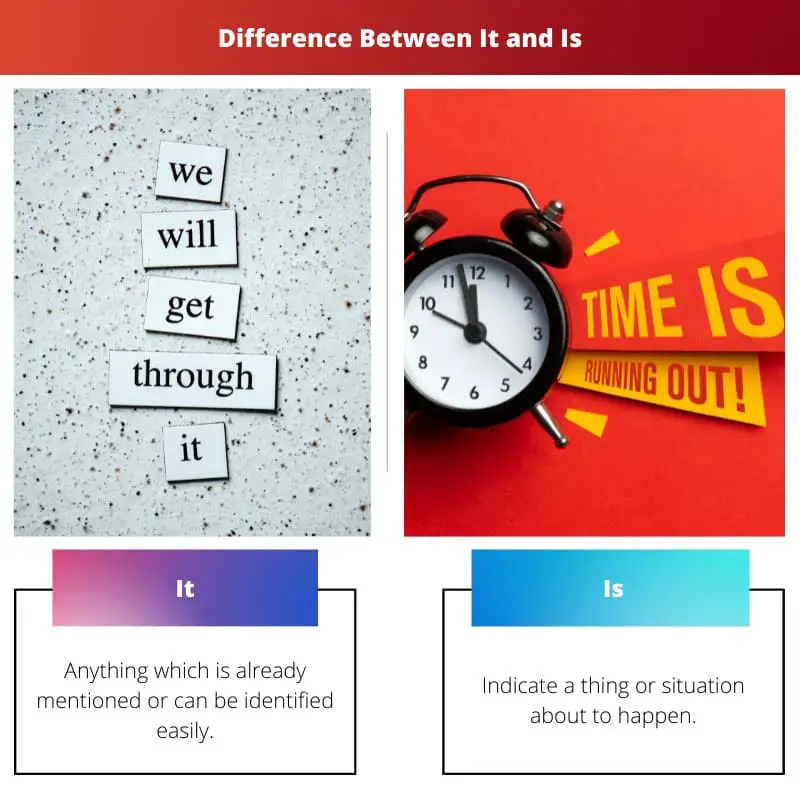‘It’ and ‘Is’ both are used in English grammar and are used in many sentences by people around the globe.
They play a very important role in the formation and meaning of sentences, but at times people use them incorrectly while forming a sentence, as both are third-person singular words. However, there are many points of difference between them.
Key Takeaways
- IT (Information Technology) deals with developing, managing, and maintaining computer systems, while IS (Information Systems) focuses on the interaction between technology, people, and processes.
- IT professionals work with hardware, software, and networks, while IS professionals analyze and optimize the use of technology within organizations.
- IS encompasses a broader scope of the study, including technology implementation’s social and organizational aspects, while IT is more technically focused.
It vs Is
The difference between ‘It’ and ‘Is’ is that ‘It’ is a third-person singular pronoun as well as a noun and an adjective in a sentence. But ‘Is’ is a singular form that falls under be verb and is used in the third person present tense and also present participle tense in a sentence.

‘It’ is commonly used in both types, such as a subject pronoun and an object pronoun, and is also used to mention many living things like – trees, animals, etc., in English text and spoken English.
The word ‘It’ is used in a sentence to refer to anything that is already mentioned or easily identified (for example, a room with three desks in it).
The word ‘Is’ is used in many ways, among which one of the ways is to indicate a thing or situation about to happen (for Example- Construction is to begin next week).
In a sentence, when there is- it/he/she /she, then automatically, the word ‘Is’ is placed after them. For example, He is a great sportsman. She is good at singing. It is a nice place to visit.
Comparison Table
| Parameters of Comparison | It | Is |
|---|---|---|
| Type of word | Third-person singular pronoun as well as a noun. | Third-person singular is a verb. |
| Referred to | Anything which is already mentioned or can be identified easily | Indicate a thing or situation about to happen |
| Placement | Usually placed at the beginning or end of the sentence | Usually placed in the middle or after the words- it/he/she, and at the beginning of an interrogative sentence. |
| Short-form | No short form is used | ‘s – is used in many sentences |
| Examples | This is a room with three beds in it. | Construction is to begin next week. |
What is It?
According to the English grammar dictionary, ‘It’ is a third-person singular pronoun as well as a noun that can be used in many ways and both as a subjective pronoun and objective pronoun or as an object of a preposition.
Now to start as a pronoun, ‘it’ is used to refer to anything which is already mentioned or can be identified easily.
A few examples are-
- He saw a white tiger in the forest. It was a thrilling moment for him.
- It is a wonderful place to visit in this city.
- My husband sat on a cake. He feels shy to talk about it.
The word ‘It’ is also used to mention a child whose gender is not known or revealed yet. For example- After the child is born, it brings happiness in our life.
‘It’ can also be used as a passive clause where it reports a situation or an event. For example-
- It has been said that stress causes insomnia.
- It is noted that the cases of illness increased significantly within a year.
Again, ‘it’ can be used as a noun to express feelings or a perspective in a situation. For example-
- It is good to see John after such a long time.
- It is a good diet plan to be healthy.
- I have this type of pen. It is really smooth in writing.
- It was a really bad experience for me.

What is Is?
‘Is’ is a third-person singular verb used in the present tense. This can be shortened and used as -’s. This word is used in many ways, among which one is to indicate a thing or situation about to happen. For example-
- Construction is to begin next week.
- There is a party organized tomorrow.
In a sentence, when there is- it/he/she, most of the time, then there is a possibility then ‘is’ is automatically placed after them. For example-
- He is a great judo player.
- She’s good at swimming.
- It is a nice place to visit next week.
The origin of ‘Is’ is from Old English (es) Indo-European to Middle English. A few examples of ‘is’ in a sentence are as follows-
- Is she not pretty?
- This is where kids have their lunch.
- Is this true what I hear about you?
In these sentences, ‘Is’ is used mostly in the middle and a few times while constructing interrogative sentences. But it is not always necessary that all interrogative sentences start with ‘is’.
In a few interrogative sentences, ‘is’ can also be in the middle of the sentences rather than in the beginning. For example-
- When is the program going to start?
- Do you think it is fair?

Main Differences Between It and Is
- ‘It’ and ‘Is’ both are third-person singular, but one is a pronoun as well as a noun or adjective, and the other is a ‘be’ verb, respectively.
- ‘It’ is referred to use at anything which is already mentioned or can be identified easily, and ‘Is’ indicates a thing or a situation that is about to happen.
- ‘It’ can be placed in an assertive sentence, whereas ‘Is’ can be placed in the beginning to make an interrogative sentence.
- ‘Is’ has a shortened term, that is- ‘s, but ‘It’ has no such shortened term.
- ‘It’ is mentioned for living things and also for children whose gender is not known, whereas ‘Is’ is mentioned for all present tense things, whether living or non-living or a girl or a boy.

- https://api.taylorfrancis.com/content/books/mono/download?identifierName=doi&identifierValue=10.4324/9780203715857&type=googlepdf
- http://125.234.102.27/handle/TVDHBRVT/15147

The breakdown of the differences between ‘It’ and ‘Is’ in the article is highly beneficial, providing useful insights for language learners.
The article offers a comprehensive understanding of ‘It’ and ‘Is,’ making it easier to apply them correctly in English sentences.
The information provided in this article helps to clarify the differences between ‘It’ and ‘Is’, two commonly confused words in the English language.
I appreciate the comprehensive explanation. It’s a great way to clearly understand the usage of ‘It’ and ‘Is’.
Thank you for sharing this helpful information. It’s an excellent resource for English learners.
The information offered in the article is commendable as it helps to dispel any confusion regarding the use of ‘It’ and ‘Is’ in sentences.
The article offers a clear and concise understanding of the differences between ‘It’ and ‘Is’, providing a valuable resource for those learning English.
This article provides an excellent guide for ensuring proper usage of ‘It’ and ‘Is’ in everyday English communication.
I am grateful for the in-depth explanation, it goes a long way in helping learners grasp the correct usage of ‘It’ and ‘Is’.
The information presented in the article is detailed and accessible, providing valuable insight into the usage of ‘It’ and ‘Is’.
This article adds clarity and depth to the understanding of ‘It’ and ‘Is’, serving as a beneficial resource for language learners.
The article is constructive in clarifying the common confusion associated with the usage of ‘It’ and ‘Is’ in English language.
The article effectively outlines the distinctions between ‘It’ and ‘Is’ in English grammar, providing useful examples for clarification.
I found the comparison table particularly helpful in understanding the context of usage for ‘It’ and ‘Is’.
The detailed explanation of the usages of ‘It’ and ‘Is’ provided in this article is very enlightening.
The comparisons and examples given in the article make it easier to grasp the finer nuances of ‘It’ and ‘Is’.
The clarity and detail provided in the article are helpful for anyone seeking to refine their understanding of ‘It’ and ‘Is’.
This article is a valuable resource in improving grammar knowledge, especially related to the usage of ‘It’ and ‘Is’.
The comprehensive examples provided in the article greatly enhance the understanding of ‘It’ and ‘Is’ in English sentences.
The article provides an insightful comparison between ‘It’ and ‘Is’, offering valuable guidance for addressing the challenges of their usage.
The detailed explanation and examples are a significant help in clarifying the correct usage of ‘It’ and ‘Is’.
This article serves as a reliable resource for understanding the distinctions between ‘It’ and ‘Is’ in English grammar.
The article effectively breaks down the differences between ‘It’ and ‘Is’, making it easy for readers to comprehend their usage.